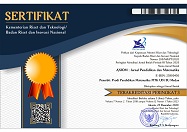REPRESENTASI MATEMATIS DAN KEMAMPUAN MATEMATIKA SISWA SMP DITINJAU DARI TAKSONOMI BLOOM
Abstract
Representasi matematis dibutuhkan untuk menyajikan ide-ide matematika. Kemampuan matematika siswa dapat dilihat dari bagaimana siswa merepresentasikan gagasannya atas suatu masalah matematis. Representasi yang digunakan siswa akan berbeda dengan siswa lainnya. Tujuan penelitian ini adalah untuk melihat representasi matematis dan kemampuan matematika siswa ditinjau dari Taksonomi Bloom. Metode yang digunakan dalam penelitian ini deskriptif kualitatif yang bertujuan untuk mendeskripsikan Representasi Matematis dan Kemampuan Matematika Siswa SMP ditinjau dari Taksonomi Bloom. Instrumen dalam penelitian ini terbagi menjadi dua yaitu instrumen utama yaitu peneliti sendiri dan instrumen pendukung yaitu lembar tes representasi matematis, lembar tes taksonomi Bloom, dan wawancara. Hasil menunjukkan bahwa secara keseluruhan kemampuan subjek dalam menyelesaikan masalah sistem persamaan linear dua variabel berbeda-beda. Hal ini terlihat dari masih terdapatnya proses penyelesaian yang belum terjawab dengan benar, meskipun representasi yang digunakan sudah tepat tetapi terdapat beberapa soal yang belum terjawab dengan benar. Sedangkan untuk kemampuan matematika yang ditinjau dari level Taksonomi Bloom, belum ada subjek yang mampu menyelesaikan soal level satu sampai enam secara berturut-turut dengan benar.
Abstract
Mathematical representations are needed to present mathematical ideas. Students' mathematical ability can be seen in how students represent their ideas on a mathematical problem. The representation used by students will be different from other students. This study aims to see the mathematical representation and mathematical ability of students based on Bloom's Taxonomy. A descriptive qualitative method was used to describe the Mathematical Representation and Mathematical Ability of Junior High School Students based on Bloom's Taxonomy. In this study, the instruments were divided into two, namely the main instrument (the researcher himself) and the supporting instruments, namely the mathematical representation test, Bloom's taxonomy test, and interviews. The results show that the overall ability of students to solve the problem of linear equations of two variables is different. This can be seen in the process of solving the mathematical problems which have not been answered correctly. Although the representation is correct, several questions have not been answered correctly. As for the mathematical ability in terms of Bloom's Taxonomy level, no subject has been able to solve level one to six questions in a row correctly.
Keywords
Full Text:
PDF (Indonesian)References
Ainsworth, S. (1999). The Functions of Multiple Representations. Computers & Education, 33(1999), 131-152.
Anderson, L.W. & Krathwohl, D.R. (2010). Kerangka Landasan Untuk Pembelajaran, Pengajaran, dan Asesmen. Yogyakarta: Pustaka Pelajar.
Bloom, B.S. 1956. Taxonomy of Educational Objectives. Canada: David McKay Company, Inc.
BSNP. (2006). Permendiknas RI No. 22 Tahun 2006 tantang Standar Isi untuk Satuan Pendidikan Dasar dan Menengah. Jakarta.
Cahdriyana, R.A., Sujadi, I., dan Riyadi. (2014). Representasi Matematis Siswa Kelas VII di SMPN 9 Yogyakarta dalam Membangun Konsep Sistem Persamaan Linear Dua Variabel. Jurnal Elektronik Pembelajaran Matematika, 2(6), 632-642.
Dahlan, J.A., dan Juandi, D. (2011). Analisis Representasi Matematik Siswa Sekolah Dasar dalam Penyelesaian Masalah Matematika Kontekstual. Jurnal Pengajaran MIPA, 16(1), 128–138.
Dreher, A., dan Kuntze, S. (2015). Teachers??? Professional Knowledge and Noticing: The Case of Multiple Representations in the Mathematics Classroom. Educational Studies in Mathematics, 88(1), 89–114. https://doi.org/10.1007/s10649-014-9577-8.
Flores, R., koontz, E., dan Inan, F.A. 2015. Multiple Representation Instruction First Versus Traditional Algorithmic Instruction First: Impact in Middle School Mathematics Classrooms. Educational Studies in Mathematics, 89(2), 267–281. https://doi.org/10.1007/s10649-015-9597-z.
Goldin, G.A. (1989). Representational System, Learning, and Problem Solving in Mathematics. Journal of Mathematical Behavior. 17(2), 137-165.
Gyamfi, K., dan Bosse, M. 2014. Processes and Reasoning in Representations of Linear Functions. International Journal of Science and Mathematics Education, 12(1), 167–192. https://doi.org/10.1007/s10763-013-9416-x.
Halat, E., dan Peker, M. (2011). The Impacts of Mathematical Representations Developed through Webquest and Spreadsheet Activities on the Motivation of Pre-service Elementary School Teachers. Turkish Online Journal of Educational Technology, 10(2), 259–267.
Hijriani, L., Rahardjo, S., dan Rahardi, R. (2017). Kesalahan Siswa SMP dalam Menyelesaikan Soal Sistem Persamaan Linear Dua Variabel. Prosiding Seminar Nasional Matematika dan Pembelajarannya. 411-418.
Hijriani, L., Rahardjo, S., & Rahardi, R. (2018). Deskripsi Representasi Matematis Siswa SMP dalam Menyelesaikan Soal PISA. Jurnal Pendidikan: Teori, Penelitian, dan Pengembangan, 3(5), 603-607.
Hwang, W.Y., Chen, N.S., Dung, J.J., dan Yang, Y.L. (2007). Multiple Representation Skills and Creativity Effects on Mathematical Problem Solving Using a Multimedia Whiteboard System. Educational Technology & Society, 10(2), 191–212.
Idris, F.H., Hamid, I., dan Ardiana. (2015). Analisis Kesulitan Siswa dalam Menyelesaikan Soal-soal Penerapan Sistem Persamaan Linear Dua Variabel. Jurnal Matematika dan Pendidikan Matematika, 4(1): 92-98.
Kartini. (2009). Seminar Nasional Matematika dan Pendidikan Matematika Jurusan Pendidikan Matematika FMIPA UNY, 5 Desember 2009. Peranan Representasi Dalam Pembelajaran Matematika, 978–979.
Krathwohl, D.R. (2002). A revision of Blooms' Taxonomy: An Overview. Theory into Practice Revising Blooms' Taxonomy: 41 (4), 212-218.
National Council of Teachers of Mathematics. (2000). Principles and Standards for School Mathematics. NCTM. Virginia.
Santia, I. (2015). Representasi Siswa SMA dalam Memecahkan Masalah Nilai Optimum Berdasarkan Gaya Kognitif Field Independent dan Field Dependent. Jurnal Math Educator Nusantara, 1(1), 67–76.
DOI: http://dx.doi.org/10.30821/axiom.v11i1.9340
Refbacks
- There are currently no refbacks.
Copyright (c) 2022 Lailin Hijriani, Swasono Rahardjo, Rustanto Rahardi

This work is licensed under a Creative Commons Attribution-ShareAlike 4.0 International License.
p-ISSN: 2087-8249 | e-ISSN: 2580-0450
Indexed by:
AXIOM : Jurnal Pendidikan dan Matematika is licensed under a Creative Commons Attribution-ShareAlike 4.0 International License.











